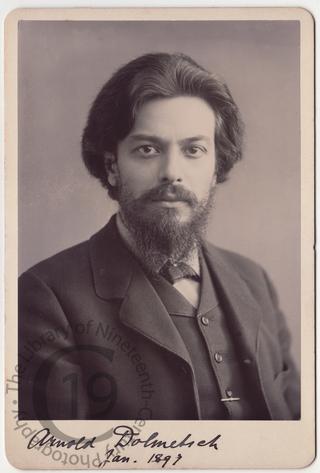
Eugène Arnold Dolmetsch
A cabinet card portrait of the musician and instrument maker Eugène Arnold Dolmetsch (1858-1940). Born in France, he spent much of his working life in England and established an instrument-making workshop at Haslemere in Surrey. He was a leading figure in the 20th century revival of interest in Early Music.
The Dolmetsch family was originally of Bohemian origin, but (Eugène) Arnold Dolmetsch was born at Le Mans in France, where the family had established a piano-making business. It was in the family's workshops that Dolmetsch acquired the skills of instrument-making that would later be put to use in his early music workshops. He studied music at The Brussels Conservatoire and learnt the violin with Henri Vieuxtemps. In 1883 he travelled to London to attend the Royal College of Music, where he studied under Henry Holmes and Frederick Bridge, being awarded a Bachelor of Music degree in 1889.
Dolmetsch was employed for a short time as a music teacher at Dulwich College, but his interest in early instruments was awakened when he saw the collections of historic instruments in the British Museum. After constructing his first reproduction of a lute in 1893, he began building keyboard instruments. William Morris encouraged him to build his first harpsichord. He left England to build clavichords and harpsichords for Chickering of Boston (1905–1911), then for Gaveau of Paris (1911–1914). He went on to establish an instrument-making workshop at Haslemere in Surrey, where he built copies of almost every kind of instrument dating from the 15th to 18th centuries, including viols, lutes, recorders and a range of keyboard instruments. His 1915 book The Interpretation of the Music of the XVIIth and XVIIIth Centuries was a milestone in the development of authentic performances of early music.
In 1925 he founded an annual chamber music festival, the International Dolmetsch Early Music Festival, which is held every July at Haslemere, in the Haslemere Hall. Dolmetsch was active in the cultural life of London, and his friends and admirers included William Morris, Selwyn Image, Roger Fry, Gabriele d'Annunzio, George Bernard Shaw, Ezra Pound, George Moore, whose novel Evelyn Innes celebrates Dolmetsch's life and work, and W. B. Yeats.
Dolmetsch was also responsible for rediscovering the school of English composers for viol consort (including John Jenkins and William Lawes), leading to Sir Henry Hadow's tribute that Dolmetsch had ‘opened the door to a forgotten treasure-house of beauty’. In 1937 he received a British Civil list pension and in 1938 he was created a chevalier of the Légion d'honneur by the French government.
He married three times and had several children. Dolmetsch encouraged the members of his family to learn the skills of instrument-making and musicianship and the family frequently appeared together in concerts, playing instruments constructed in the Dolmetsch workshops. Following the death of Arnold Dolmetsch at Haslemere in 1940, his family continued to promote the building and playing of early instruments.
Photographed by Alexander Bassano of London.
Code: 125488




